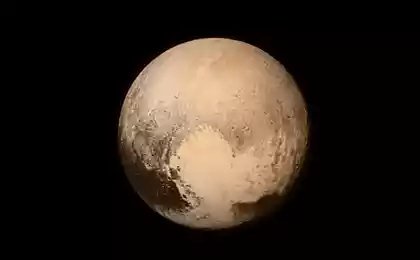238
Pluto and other dwarf planets have astrobiological potential
"It's very exciting to know that dwarf planets may have astrobiological potential," says New Horizons project lead scientist Alan Stern of the Southwest Research Institute. In 2011, the highly sensitive spectrograph Cosmic Origins aboard the Hubble Space Telescope detected a strong absorber of ultraviolet waves on the surface of Pluto, providing new evidence of the possible presence of complex hydrocarbons or nitrile molecules on the surface of the planet. These chemical compounds can be produced by interacting sunlight or cosmic rays with Pluto’s known surface ices, including methane, carbon monoxide and nitrogen.
“This is an exciting discovery because Pluto’s complex hydrocarbons and other molecules that may be responsible for the ultraviolet spectral features, among other things, may be responsible for the formation of Pluto’s ruddy color,” Stern said.
The team also found evidence of changes in Pluto’s ultraviolet spectrum based on Hubble measurements since the 1990s. The changes could be due to different terrains than they were in the 1990s, or other effects, such as a sharp increase in Pluto’s atmospheric pressure over the same time period.
“The discovery we made with Hubble reminds us that there will probably be even more exciting discoveries about Pluto’s composition and surface when NASA’s New Horizons spacecraft arrives at Pluto in 2015,” Stern adds.
If the icy surface of Pluto's giant moon Charon is covered in cracks, analysis of the faults could show that its interiors were warm. Perhaps warm enough to keep underground oceans of liquid water. Pluto, once thought to be a planet, is in the Kuiper Belt, a collection of frozen objects orbiting the Sun at a distance of 30 to 50 astronomical units. One astronomical unit is the distance from the Earth to the Sun, about 150 million kilometers.
Pluto is an extremely distant world, orbiting the Sun almost 29 times farther away than Earth. With a surface temperature of 229 degrees Celsius below zero, Pluto’s environment is too cold to allow liquid water to exist on its surface. Pluto’s moons are in similar frozen conditions. Pluto’s remoteness and small size make it difficult to observe, but in July 2015, the New Horizons spacecraft will be the first to visit Pluto and Charon and provide detailed data for study.
"Our model suggests different patterns of faults on Charon's surface depending on the thickness of the ice on the surface, the structure of the moon's interiors, and how simply it deforms," says Alyssa Rodin of the Goddard Space Flight Center in Greenbelt, Maryland. By comparing the actual observations of Charon’s New Horizons with previous predictions, we can select a suitable option and determine whether there may have been an underground ocean on Charon in the past, due to its high eccentricity. ?
Some moons around the gas giants of the outer solar system have shown that they possess oceans below the surface — Jupiter’s moon Europa and Saturn’s moon Enceladus, for example.
Although Pluto's surface temperature hovers around -230 Celsius, researchers have long wondered whether the dwarf planet could store enough internal heat to maintain a liquid ocean beneath the icy surface.
Guillaume Robuchon and Francis Nimmo of the University of California, Santa Cruz have calculated that the presence of an ocean depends on two things: the amount of radioactive potassium in Pluto's rocky core and the temperature of the ice covering the planet.
Density measurements showed that the rocky core occupies 40% of the dwarf planet’s volume. If the core contains potassium at a concentration of 75 parts per billion, its decay can produce enough heat to melt some areas of surface ice consisting of nitrogen and water.
The planet should have enough potassium and, more likely, huge reserves. This is stated by William McKinnon of Washington University in St. Louis, citing the example of the Earth, which was formed with less volatile substances in its core due to the closer distance to the Sun — 10 times smaller.
The heat of Pluto’s core will trigger convection in the surrounding ice, and if the ice melts too quickly, the heat will simply escape into space before the ice melts. If the ice melts more slowly than in the glaciers of Antarctica on Earth, the upper 165 kilometers of ice will provide sufficient insulation for the existence of a liquid ocean at that depth.
The viscosity of the ice depends on the size of the individual ice particles, as the ice from smaller granules melts more quickly. There’s no way to measure this from Earth, but Pluto’s shape may indicate an ocean beneath its surface. Things will become clearer when the New Horizons probe begins to study and image the shape of the planet in 2015.
Source: hi-news.ru
Source: /users/1617
BMW Point.One S – electric vehicle charging station is solar powered
The office dinner— chicken breast with vegetable sauce























